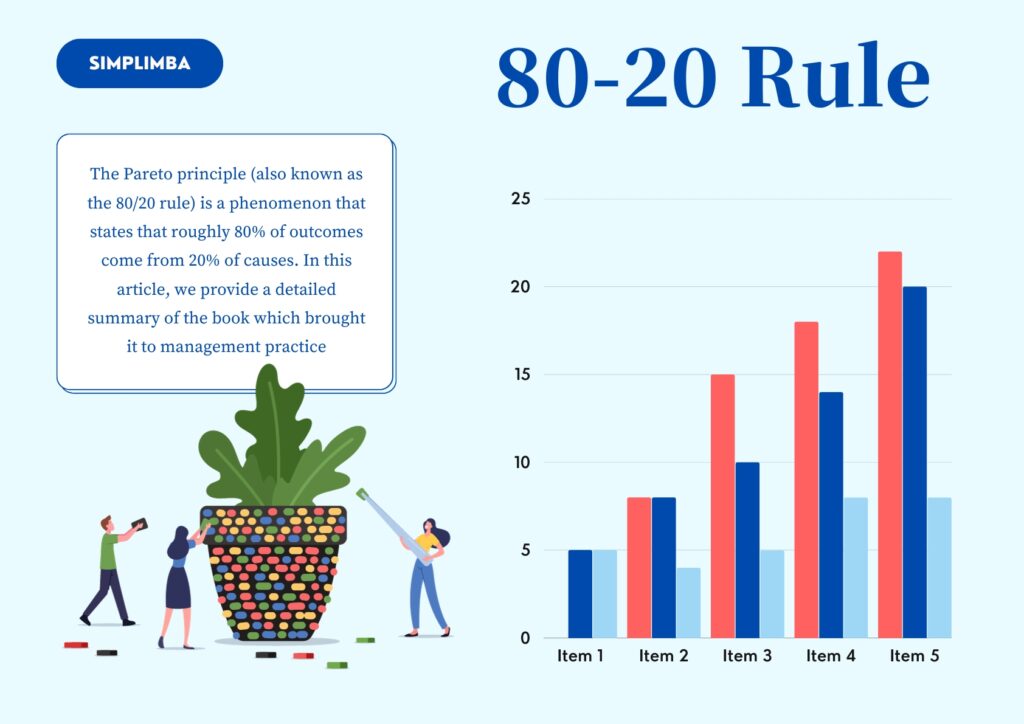Welcome to the world of “The 80/20 Principle” by Richard Koch. In this fascinating book, Koch unravels the power of the 80/20 principle, also known as the Pareto Principle, and its profound impact on various aspects of our lives. With his authoritative voice, data-oriented approach, and engaging writing style, Koch takes readers on a journey of discovery, showing how this principle can revolutionize the way we think about management, leadership, and time management.
Drawing inspiration from the economist Vilfredo Pareto, who first observed the 80/20 principle in action over a century ago, Koch presents a compelling case for its applicability across diverse fields. Whether you’re a business professional striving for improved productivity, a student seeking smarter time management techniques, or an individual looking to enhance personal relationships, this book has something to offer.
Through a series of chapters, Koch guides us through the practical application of the 80/20 principle. We explore how businesses can identify the vital few factors that drive their success, allowing them to focus their efforts and resources for maximum results. We uncover the secrets to efficient time management, discovering how to prioritize tasks and eliminate distractions to optimize our productivity. We delve into problem-solving and decision-making, learning how to pinpoint the root causes of issues and develop targeted solutions. And we even uncover how the 80/20 principle can guide us to find happiness and fulfillment in our personal relationships.
With every turn of the page, Koch offers thought-provoking insights, backed by real-life examples and empirical evidence. He challenges conventional wisdom, encouraging us to think critically and question our current approaches. Combining theory with practical strategies, he equips us with the tools we need to apply the 80/20 principle in our own lives, unlocking our latent potential for success and fulfillment.
About the Author
Richard Koch is a British author, entrepreneur, and management consultant. He holds an MBA from the Wharton School of Business and has had a successful career in business, including co-founding LEK Consulting, a leading global management consulting firm. Koch has written several books on business and personal development, with “The 80/20 Principle” being one of his most popular works. He is known for his expertise in practical strategies for maximizing productivity and effectiveness.
Style of Writing
Richard Koch’s writing style is authoritative, data-oriented, and engaging. He combines his extensive knowledge and experience in business with a witty and relatable tone, making complex ideas accessible to readers. Koch’s writing is well-researched, and he supports his points with real-world examples and evidence. His content is structured and organized, allowing readers to easily follow along and understand the principles he presents. Koch’s writing style is suitable for both academic and general audiences, as he balances the use of data and research with practical applications and anecdotes. Overall, his engaging writing style makes his books, including “The 80/20 Principle,” a pleasure to read while still providing valuable insights and actionable strategies.

The 80/20 Principle Chapter Wise Summary
Chapter 1: The 80/20 Principle – An Introduction
In the opening chapter of “The 80/20 Principle,” Richard Koch introduces readers to the concept of the 80/20 principle, also known as the Pareto Principle. He explains that this principle states that 80% of results come from just 20% of causes.
Koch explores the origins of the principle and shares how it was first discovered by economist Vilfredo Pareto in the late 19th century, who found that 80% of the land in Italy was owned by just 20% of the population. This principle can be applied to various aspects of life, including business, personal productivity, and time management.
In the opening chapter of “The 80/20 Principle,” Richard Koch introduces readers to the concept of the 80/20 principle, also known as the Pareto Principle. He explains that this principle states that 80% of results come from just 20% of causes.
Koch begins the chapter with a poignant quote from Vilfredo Pareto, the economist who first discovered the 80/20 principle: “The distribution of wealth and income in any society is in general very unequal, but attempts to reduce or eliminate this inequality by a redistribution of incomes in favor of the poorer members of society, without an attempt to change the rules of the game, are rather like trying to empty the deep end of a swimming pool with a teaspoon.“
To illustrate the concept, Koch provides an example from the world of finance: “In the stock market, approximately 80 percent of profits come from 20 percent of the investments,” he states. This example highlights how a small fraction of investments contribute to the majority of gains, while the remaining investments yield minimal returns.
Koch also touches upon the idea that the 80/20 principle applies to personal relationships: “20 percent of your contacts produce 80 percent of the value you receive from your connections,” he writes. This perspective encourages readers to assess the quality and significance of their relationships and focus on nurturing the ones that bring the most satisfaction and fulfillment.
Through these quotes and examples, Koch establishes the foundation for understanding the 80/20 principle and its broad applicability in various domains of life. By recognizing that a minority of causes generate the majority of results, individuals can start to harness the power of this principle to improve their decision-making, time management, and overall productivity.
Chapter 2: Applying the 80/20 Principle in Business
In this chapter, Koch delves into the application of the 80/20 principle in the business world. He explains how understanding the principle can lead to significant improvements in productivity and profitability. By identifying the crucial few factors that contribute to the majority of results, businesses can focus their efforts on the most effective areas.
Koch cites numerous examples of successful companies that have applied the 80/20 principle to their operations. He emphasizes the importance of prioritizing tasks and resources based on their impact and provides strategies for implementing this principle in business decision-making.
Koch states, “The message of The 80/20 Principle is that most of what you achieve in your job (as in your personal life, your community life, and generally) comes from a small proportion of what you do. The message is that there is usually a catch to any idea, a crucial flaw, a hazard—and by concentrating on that catch, flaw, or hazard, you can uncover a totally unsuspected chance for enormous success.”
He explains that by focusing on the crucial few factors that contribute to the majority of results, businesses can prioritize their efforts and resources effectively. He provides examples of successful companies that have applied the 80/20 principle:

1. Apple: Koch mentions that Apple discovered that 20% of their products generated 80% of their profits, leading them to focus on their most successful products such as the iPhone and iPad.
2. McDonald’s: Koch highlights how McDonald’s implemented the 80/20 principle to streamline their menu and focus on their most popular items, leading to increased efficiency and customer satisfaction.
3. Microsoft: Koch explains that Microsoft found that 80% of software problems were caused by just 20% of bugs, allowing them to prioritize their bug-fixing efforts and improve the overall quality of their products.
Koch also explores the concept of customer segmentation and how it relates to the 80/20 principle. He quotes, “Not only do most companies’ customers profit from the 80/20 Principle in the sense that 80 percent of their benefits come from 20 percent of their purchases, but the companies draw 80 percent of their rebates from 20 percent of their products.”
He emphasizes the importance of identifying the vital few customers who generate the majority of revenue and focusing on providing exceptional value to them. By understanding customer segmentation, businesses can allocate their resources more effectively and improve customer satisfaction.
Koch provides strategies for implementing the 80/20 principle in business decision-making:

1. Prioritization: He advises businesses to prioritize tasks, projects, and investments based on their impact and potential to generate results. This allows companies to focus their efforts on the most critical areas.
2. Elimination: Koch suggests eliminating or reducing low-value activities, products, and processes that don’t contribute significantly to the company’s overall results. This frees up resources to invest in high-impact areas.
3. Innovation: He encourages businesses to innovate and experiment to find new ways to improve efficiency and effectiveness. By continually seeking out new opportunities and approaches, companies can stay ahead of the competition.
Chapter 3: Time Management and the 80/20 Principle
In this chapter, Koch explores how the 80/20 principle can be used to improve time management. He argues that most people waste their time on low-value tasks and activities that do not contribute to their desired outcomes. By applying the 80/20 principle, individuals can identify the critical activities that generate the most significant results.
Koch provides practical tips for applying the 80/20 principle to time management, such as delegating low-value tasks, prioritizing high-impact activities, and minimizing distractions. He also discusses the importance of focus and concentration in achieving maximum productivity.
Koch starts by highlighting the common problem of wasting time on low-value tasks and activities that do not contribute to desired outcomes. He states, “Most people spend a majority of their time on trivial matters that produce little or no value”.
He then introduces the concept of “vital few” activities, those tasks that have the most significant impact on results. Koch explains, “The goal of the 80/20 principle in time management is to identify the small number of activities that contribute the most value and prioritize them”. By focusing on these vital few activities, individuals can maximize their productivity and achieve greater results in less time.
To illustrate the application of the 80/20 principle in time management, Koch provides several relevant examples. One example he mentions is the ratio of productive time in a typical workday. He states, “In a standard eight-hour workday, research suggests that individuals typically have only 1.6 hours of productive time, or 20% of their working hours. The remaining 80% is often wasted on non-value-added tasks and distractions”. This highlights the need to identify and prioritize the activities that contribute to the desired outcomes.
Koch also emphasizes the importance of focus and concentration in achieving maximum productivity. He quotes psychologist Mihaly Csikszentmihalyi, who states, “The best moments in our lives are not the passive, receptive, relaxing times… The best moments usually occur if a person’s body or mind is stretched to its limits in a voluntary effort to accomplish something difficult and worthwhile”. This quote emphasizes the power of deep work and being fully engaged in high-value tasks.
Furthermore, Koch offers practical tips for applying the 80/20 principle in time management. He suggests strategies such as delegating low-value tasks, minimizing distractions, and leveraging technology to automate repetitive or low-impact activities. He also advises individuals to allocate their time and energy based on the impact each task or activity has on desired outcomes.
Chapter 4: Problem Solving and Decision Making with the 80/20 Principle
In this chapter, Koch explores how the 80/20 principle can be applied to problem-solving and decision-making processes. He explains that most problems stem from a small number of causes and that focusing on these root causes can lead to more effective solutions.
Koch provides a step-by-step framework for applying the 80/20 principle to problem-solving, including identifying the critical few causes, developing targeted solutions, and monitoring results. He also emphasizes the importance of experimentation and learning from failures to continually improve decision-making processes.
Koch begins the chapter by highlighting a key insight: “It is the quality of our thinking that determines the quality of our decisions and actions.” He emphasizes the need to tackle problems at their core, rather than simply addressing surface-level symptoms. By identifying the vital few causes responsible for the majority of problems, we can achieve significant improvements.
To illustrate the power of the 80/20 principle in problem-solving, Koch provides various examples. One such example is the principle of marginal gains used by the British cycling team. By focusing on improving multiple small factors that contribute to performance, such as diet, training tactics, and equipment, the team was able to achieve remarkable success. This approach aligns with the 80/20 principle since a few key factors can have a substantial impact on the overall outcome.
Koch also discusses the concept of “satisfice,” a term coined by Nobel laureate Herbert Simon, which means to satisfy and suffice rather than pursue perfection. He explains that by applying the 80/20 principle, we can prioritize finding satisfactory solutions for the vital few causes, rather than striving for unattainable perfection in every aspect.
The author introduces a practical framework for applying the 80/20 principle to problem-solving:
1. Identify the vital few causes: Rather than getting overwhelmed by numerous factors, focus on the small number of causes that have the most significant impact. Koch quotes management consultant Edward de Bono, who said, “An expert is someone who has learned what not to do.”
2. Develop targeted solutions: Once the critical causes are identified, devise specific solutions that address these root causes directly. Koch emphasizes the importance of experimentation and learning from failures to refine these solutions continuously.
3. Monitor results: Regularly track the impact of the implemented solutions to ensure they are producing the desired outcomes. Koch advises, “Measurements are the key to progress.”
Throughout the chapter, Koch provides real-life examples of companies and individuals who have successfully applied the 80/20 principle to problem-solving. He highlights how the Japanese manufacturing philosophy of Kaizen, where small improvements are continuously made, aligns with the principle’s core concepts.

Chapter 5: Happiness and Relationships with the 80/20 Principle
In the final chapter, Koch discusses how the 80/20 principle can be applied to achieve happiness and fulfillment in personal relationships. He argues that focusing on the vital few relationships and nurturing them can lead to greater happiness and satisfaction.
Koch provides practical advice for applying the 80/20 principle to personal relationships, such as identifying the most important people in one’s life, investing time and effort into those relationships, and setting boundaries to protect one’s energy and well-being. He also emphasizes the importance of self-reflection and personal growth in building meaningful connections.
Koch begins by highlighting the importance of relationships in our lives, stating, “our personal relationships are the source of most of our everyday happiness and unhappiness“. He emphasizes that not all relationships are equal and that applying the 80/20 principle can help in identifying and prioritizing the most significant relationships.
To illustrate this, Koch provides the example of a woman named Sarah who found that 80% of her happiness came from only 20% of her relationships. By focusing more on these vital few relationships, Sarah was able to improve her overall happiness and decrease the time and energy spent on less fulfilling connections.
Koch suggests that individuals should reflect on their relationships and identify the key people who contribute the most to their happiness and satisfaction. He advises readers to consider factors such as emotional support, shared values, and mutual respect when evaluating the significance of relationships.
Once the crucial relationships have been identified, Koch advises readers to invest time and effort into nurturing and strengthening these connections. He explains, “by focusing on the 20 percent, we ensure that the efforts we make in our relationships are more likely to yield exponential rewards“.
Koch also emphasizes the importance of setting boundaries in relationships to protect one’s energy and well-being. He explains that not all relationships will bring equal satisfaction and that it is okay to limit time and resources spent on draining or toxic relationships.
To further illustrate the application of the 80/20 principle in relationships, Koch shares the example of a man named Chris who realized that the majority of his conflicts and frustrations came from only a few key relationships. By addressing the root causes of conflict and working on improving these specific connections, Chris was able to experience greater harmony and happiness in his personal life
Samrat is a Delhi-based MBA from the Indian Institute of Management. He is a Strategy, AI, and Marketing Enthusiast and passionately writes about core and emerging topics in Management studies. Reach out to his LinkedIn for a discussion or follow his Quora Page

